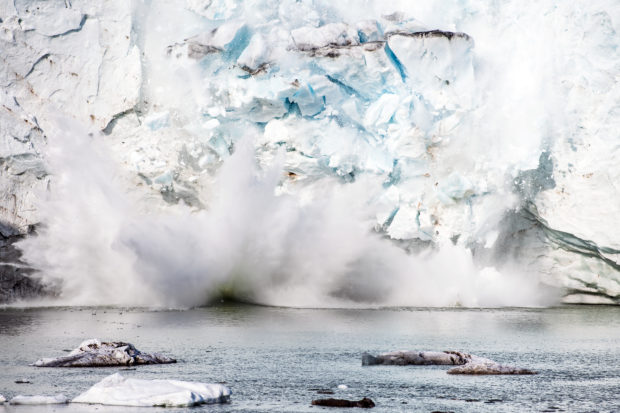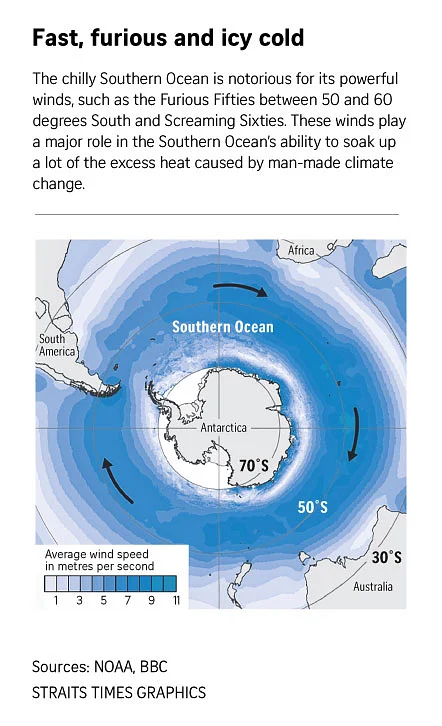More extreme El Niño, La Niña events could drive global warming, study finds

This file photo taken on August 17, 2019 shows an iceberg calving with a mass of ice breaking away from the Apusiajik glacier, near Kulusuk (aslo spelled Qulusuk), a settlement in the Sermersooq municipality located on the island of the same name on the southeastern shore of Greenland. AFP
SINGAPORE — At the bottom of the world is the wild Southern Ocean, where huge seas are whipped up by westerly winds with names such as the Roaring Forties and the Furious Fifties.
But as remote and inhospitable as the freezing Southern Ocean might seem, it plays an outsized role in regulating global climate and making life on Earth possible by acting as a huge heat sink and moderating the impacts of global warming.
It also soaks up large amounts of carbon dioxide, the main greenhouse gas.
Oceans absorb about 90 per cent of the excess heat caused by man-made climate change – the Southern Ocean being responsible for absorbing most of it.
But a study published on June 28 in the journal Nature Climate Change said climate change could cause the Southern Ocean to absorb less heat, allowing more to remain in the atmosphere.
Article continues after this advertisement“This would contribute to an increase in the rate of global warming,” said co-author Dr Agus Santoso of the Climate Change Research Centre at the University of New South Wales in Sydney.
Article continues after this advertisementDr Santoso and an international group of researchers led by Dr Guojian Wang of the Centre for Southern Hemisphere Oceans Research in Hobart used computer models to investigate how the Southern Ocean might be affected by changes in the frequency and intensity of the El Nino-Southern Oscillation (Enso), a naturally occurring Pacific Ocean phenomenon that has major impacts on the world’s weather.
Enso comprises the El Nino warm phase and La Nina cool phase. These are periodic events, with El Ninos usually having a stronger influence but lasting only a year or so while La Ninas can last longer, sometimes up to two years. The latest La Nina, which started in 2020, has only just ended.
El Nino is a warming of the ocean surface in the central and eastern tropical Pacific Ocean. This triggers heavy rain in parts of South America and dry, hotter weather in Southeast Asia and Australia. Strong El Ninos typically lead to a spike in global temperatures.
La Ninas lead to a cooling of the waters off equatorial South America and a strengthening of the winds blowing towards East Asia, piling up warmer water around the region and triggering cooler and wetter weather.
The concern is the impact climate change will have on Enso events and what this means for the wind and ocean circulation patterns in the Southern Ocean.
Using computer modelling, the research team found a strong correlation between more intense Enso events predicted for the future, especially strong El Nino episodes, and disruption of the high-latitude winds in the southern hemisphere.
Most climate models project an increased number of extreme Enso events – meaning hotter El Nino and cooler La Nina events.
Dr Wang told The Straits Times that if this increase in Enso intensity occurs in the future, “it would lead to reduced efficacy in Southern Ocean heat uptake with more heat retained in the atmosphere, and make our future world even hotter”.
Cold temperatures in the Southern Ocean make it particularly good at absorbing heat from the air.
Dr Wang and Dr Santoso explained that the Southern Ocean features a strong westerly wind-driven overturning circulation, with an upwelling branch in its south that brings water from the deep ocean layers to the surface.
A process called the Ekman transport moves the upwelled water northward before it is returned to the deep ocean.
This circulation has enabled the Southern Ocean to be responsible for 60 to 90 percent of global ocean heat absorption since 2006, the authors said.
“El Nino tends to be stronger than La Nina and a consequence of the projected stronger Enso variability would be a northward shift of the circulation, that is, less efficient heat uptake in the long term,” Dr Santoso said.
He added that it was not clear how much hotter the world could become if the Southern Ocean heat uptake weakens, and further study would be needed on its direct impacts on South-east Asia.
But models show that a warmer world will likely cause hotter temperatures and higher rainfall in the region, as well as more intense droughts, Dr Santoso said.
Associate Professor Koh Tieh Yong of the Singapore University of Social Sciences, who was not part of the study, said the research was important for understanding how changes to the strength of Enso events could influence long-term climate change for the atmosphere.
He also said it was not still not clear what would occur if the Southern Ocean’s heat uptake weakened.
“If this residual heat is less near the surface, more in the higher levels, the global warming may be less, not more,” Prof Koh, a weather and climate scientist, told ST.
He also noted that the computer model responses in terms of Enso intensity changes per degree of global warming were highly uncertain and different between models.
“So, the projections for Southern Ocean’s heat uptake and whole-atmosphere warming are likewise uncertain,” he said.
Nonetheless, the research shows the vulnerability of the Southern Ocean to changes in wind and ocean circulation patterns triggered by global warming.
Other recent research has shown that, for now, the Southern Ocean also remains a significant carbon sink.
A study sponsored by Nasa and published in December last year found that the Southern Ocean absorbs more carbon from the atmosphere than it releases, further confirming it is an important buffer against climate change.
RELATED STORIES
Climate change is driving 2022 extreme heat and flooding
Climate talks test global resolve on warming
